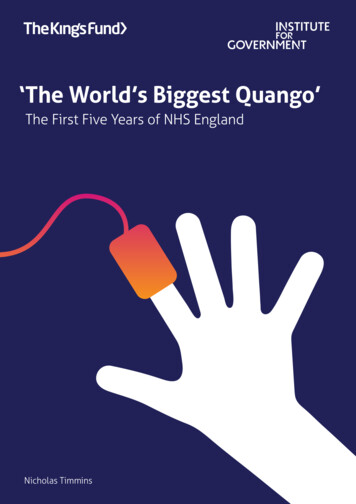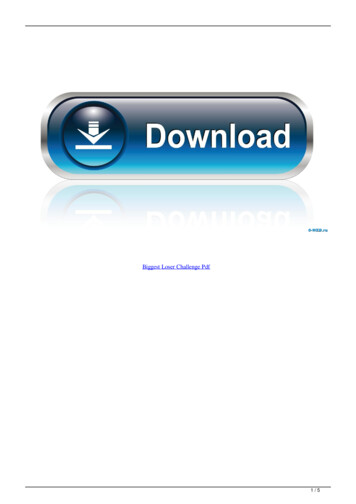
Transcription
‘The World’s Biggest Quango’The First Five Years of NHS EnglandNicholas Timmins
About this reportFive years ago, the Health and SocialCare Act 2012 created NHS England – astatutorily independent commissioningboard for the NHS.This report – drawing on extensiveinterviews, many of them exclusive, withsome of those most intimately involvedin the first five years of its existence –asks “What happened next?”The answer is something distinctlydifferent from what the Act intended.
Frontispiece design by Jon Twin, Bowyer Press
“If you ask me what is the best way of running an organisation as massive and complicatedas the health service, I would not say that it was to have all the strands going back to thehealth department. It would be much better to have it run as you would run any other bigorganisation, but with that organisation being responsible to the minister.”Norman FowlerSecretary of State for Social Services (and thus for health), 1981–87, in a 2008 interview1“There is the inherent difficulty of the whole thing. Is it possible, in any business or in anyorganisation, truly to separate policy from execution?”William WaldegraveSecretary of State for Health, 1990–92, and former aide to Arnold Weinstock at GEC2“I was actually quite attracted by the idea of an NHS commissioning role the independence,or greater degree of independence of NHS England, and the very clear responsibility that theyhave got for the NHS is, I think, helpful [Although] the distinction between policy andimplementation is never as clear as people sometimes pretend.”Patricia HewittSecretary of State for Health, 2005–073“If politics has a respectable role it is obviously in providing accountability for taxation.And if that does not apply in respect of the NHS, then what does it apply to?”Andy BurnhamSecretary of State for Health, 2009–10, and opposition health spokesperson, 2010–154“If the problem is the way politicians behave, then why don’t politicians just changetheir behaviour?”John ApplebyChief Economist, The King’s Fund, in 20065“If the purpose of setting this all out in legislation, as Andrew [Lansley] has said, wasto make it permanent, so that it could not be changed well, it hasn’t been changed.It’s just been ignored!”David Bennettformer Chair and Chief Executive of Monitor6“[The Health and Social Care Act was] our biggest mistake in government”Anonymous Conservative cabinet minister in 2014,7 echoed by Stephen Dorrell, Secretaryof State for Health, 1995–97, and chair of the Health Select Committee, 2010–148“We have to recognise that we are a democracy. And people want to hold people like me,rightly, accountable, for over 100bn of public money. So there are always going to betimes when the Health Secretary has to involve themselves in operational issues.”Jeremy HuntSecretary of State for Health, 2012–present, at a Nuffield Trust summit in 2014
logue10Act One – From Bevan’s slops to Lansley’s liberation: 1948 to 201013Scene One – From administration to planning: 1948 to 1983“The Promised Land”13Scene Two – From planning to management: 1983 to 1987“Looking for the lady with the lamp”18Scene Three – From management to the internal market: 1987 to 1997“To market, to market”21Scene Four – Targets and terror – and markets: 1997 to 2010“Eye of the Tiger”25Scene Five – Autonomy and accountability meet ‘self-improvement’“Anything you can do, I can do better”28Act Two – ‘Liberating the NHS’: 2010 to 201333Scene One – Lansley legislates “They used to tell me I was building a dream ” or “Ship of fools”33Scene Two – Building the board“River deep, mountain high”37Act Three – NHS England’s first 18 months: 2013 to 2014Scene One – Jeremy Hunt arrives and so does Robert Francis“Sturm und drang”4949Scene Two – “Tell me why I don’t like Mondays”54Scene Three – “Lawyers, guns and money ”61Scene Four – Policy and operations collide“How independent is independent?”63
Act Four – Unpacking the Health and Social Care Act: 2014 to 201765Scene One – A change of chief executive“Will ye no come back again?”65Scene Two – The Five Year Forward View“See my tailor, he’s called Simon. I know it’s going to fit”66Scene Three – The money arrives and goes out of the window“Out of control”70Scene Four – The workarounds begin“Round, round, get around, I get around ”72Scene Five – Out of the European Union.“Now that you are gone ”75Scene Six – And away from the purchaser/provider split “Come together”76Scene Seven – And out of favour “Tubthumping”76Act Five – 2017 to 2018: “Putting Humpty Dumpty together again”79Scene One – Hunt adapts his approach“Getting it right the first time ”79Scene Two – For this much you can have that much“Can’t give you more ”81Scene Three – Trying to tie a knot“Love and marriage.”83Scene Four – Judicial reviews“You bring your lawyer and I’ll bring mine.”86Scene Five – Give me money“I will, I will, I will”87Analysis and conclusion93Timeline114Glossary116References118
AcknowledgementsThis piece was conceived back in 2012 as the Health and Social Care Act became law.We – The King’s Fund and the Institute for Government – set out to try to tell the tale ofwhat happened subsequently through interviews as it went along, rather than simplygoing back some years later, and asking what had happened – an attempt, in otherwords, to capture how it felt at the time, rather than just asking some of those involvedto reveal their view in retrospect, adjusting it for what subsequently happened.That was only possible because a considerable number of people agreed to beinterviewed, often more than once, on a ‘not for direct attribution’ basis, but on theunderstanding that, at the time of writing, we would see what could, and could not,subsequently be put on the record. That involved a very considerable degree of trust,for which the author in particular is deeply grateful. As the text illustrates, much hasgone on the record; some has had to remain non-attributable.Thus, the author in particular is deeply indebted to all those who helped so much –without them this piece would have been impossible – and to those, both inside andoutside the story, who read assorted drafts of the text. Those outside, or partiallyoutside, included Jill Rutter, Chris Ham, Patrick South, Bill Morgan and Andy Cowper.It is invidious to name those inside, but they know who they are. Matthew Batchelorand Rowena Mayhew edited the text, as ever, with élan. All of these improved it no end,correcting facts and challenging analysis and opinion. For all their immense help, theycannot be held responsible for any errors of fact, let alone of judgement or opinion;although both The King’s Fund and the Institute for Government, and I, trust we havenot traduced anyone.ACKNOWLEDGEMENTS5
ForewordNicholas Timmins’ account of the Health and Social Care Act 2012 – Never Again? 1 –told the story of the biggest and most complex piece of legislation in the history of theNHS. The story ended just after the Act reached the statute book, leaving uncertainwhat would happen next. In this new study, commissioned jointly by the Institute forGovernment and The King’s Fund, Nicholas explores the fate of one of the centralprovisions of the Act, NHS England, established as a statutorily independent boardwith the aim of distancing politicians from the day-to-day running of the NHS.The story that unfolds in the pages that follow draws on interviews with those involvedin the work of NHS England, either directly or indirectly, to illustrate how there are‘many opportunities for the intentions of radical reformers to be altered and distortedas they are carried into action’, to borrow from our Foreword to Never Again? Far fromfunctioning at one step removed from the NHS, as Andrew Lansley had intended,health ministers continue to be closely involved in its operations. Despite this, NHSEngland has asserted its independence on a number of issues, demonstrating thatrelationships between ministers and arm’s-length bodies cannot be reduced to azero-sum game.The growing financial and operational pressures facing the NHS in the five years sinceNHS England was established help explain why politicians retain close involvement inits performance. Survey evidence shows that the public see the NHS as one of the mostimportant issues facing the country and also that there is rising anxiety about its future.2,3Whatever the intentions of those who framed the 2012 Act, the Health Secretary of theday will be held to account by Parliament for the performance of the NHS and will beexpected to intervene when things go wrong, as happened so spectacularly in the caseof harm to patients at Mid Staffordshire NHS Foundation Trust.If the buck stops with the Health Secretary, then there are still choices to be made bythe occupant of that office on how to discharge his or her responsibilities. Nicholasshows that Jeremy Hunt brought his own distinctive approach to the role, reflected inregular Monday morning meetings with leaders of the various national bodies involvedin the NHS. These meetings often focused on detailed aspects of NHS performance,underlining the inherent difficulty of separating policy from operations. Hunt alsotook on the mantle of the patient’s champion, using the report of the inquiry intoMid Staffordshire to shift the focus away from Lansley’s technocratic vision to patientsafety and how it could be improved.If the importance of personalities is one of the themes of this study, then the partplayed by Simon Stevens as Chief Executive of NHS England since 2014 is just asimportant as that of Jeremy Hunt. As a former special adviser to Tony Blair and AlanMilburn, Health Secretary between 1999 and 2003, and also a former NHS manager,Stevens brought a combination of experience and intellect that was exceptional in aleader of an arm’s-length body. This helps to explain his willingness to use the statutoryindependence of NHS England to speak out on the funding of the NHS and what it coulddeliver within available resources. It is difficult to imagine this being done by those whohad served as chief executives of the NHS before the creation of NHS England.6‘THE WORLD’S BIGGEST QUANGO’
One of the consequences was that Stevens and Hunt became increasingly aligned inmaking the case for additional NHS funding. The close identification of secretaries ofstate with the departments and services for which they are responsible is of course awell-understood aspect of life in Whitehall. In Hunt’s case it was reinforced by thelength of time he served as Health Secretary. The arguments of Hunt and Stevens forthe NHS budget to be increased initially fell on deaf ears but were eventually heardwhen the Prime Minister announced in evidence to the House of Commons LiaisonCommittee that the Government was preparing to announce a multi-year fundingsettlement for the NHS in recognition of the need for a sustainable funding solution.To emphasise the role of personalities is to leave open the question of what mighthave happened under a different health secretary or indeed a different chief executiveof NHS England. For now, Nicholas’s account provides riveting reading for NHS insiderson a critical period in health policy and an invaluable case study into the relationshipsbetween departments of state and arm’s-length bodies. We are grateful to Nicholasand all those who agreed to be interviewed by him for producing another first draftof history.Bronwen Maddox, Director, Institute for GovernmentChris Ham, Chief Executive, The King’s FundMay 2018FOREWORD7
IntroductionThis is, so to speak, Never Again? Part two.Never Again? 1 told the story of what preceded Andrew Lansley’s hugely controversialHealth and Social Care Act 2012, and how it became law. The legislation caused thesingle biggest political row about the NHS since the implementation of KennethClarke’s Working for Patients2 – the white paper that back in 1989 led to the originalpurchaser/provider split in the NHS. It also produced easily the biggest NHSreorganisation since at least 1974.At times it looked as though Lansley’s bill might be lost.As the Act was passed it was seen by its bitterest critics as the springboard for massprivatisation of the supply side of the NHS. Many, many more services would becontracted out to the private and voluntary sectors.And, for some of the critics at least, that was merely the presumed prelude toprivatisation of the demand side – the way the service is charged for and funded.The aim, they believed, was to use it as a staging post to the introduction of manymore charges, or a new form of private or social insurance to replace the essentiallytax-funded and largely free-at-the-point-of-use nature of the NHS. To its fiercestopponents, the Act was designed to dismantle the NHS.By contrast, its author – Andrew Lansley, who had been Conservative healthspokesperson for an unprecedented six-and-a-half years – saw it as an essentialpiece of legislation, not just to maintain and improve the NHS but also to depoliticiseits management. Its aim was to set the service free, in the words of his white paperEquity and Excellence: Liberating the NHS,3 from the “political micromanagement” and“political interference” by ministers that – in his view, and that of many others – haddogged the NHS since its inception in 1948.One of the key means of doing that was to create, for the first time, a statutorilyindependent commissioning board (later known as NHS England), a board that wasinstantly dubbed – thanks to its 100 billion budget – “the world’s biggest quango”* byAndy Burnham, the former Health Secretary and, at the time, opposition healthspokesperson.4The aim of the board, allied to other changes in the legislation, was to put an end to the“excessive bureaucratic and political control” of the service, in the words of Lansley’swhite paper. The NHS would move instead to “a system of control based on quality andeconomic regulation, commissioning and payments by results, rather than national andregional management”.5*NHS England is not, of course, ‘the world’s biggest quango’. For example, the federally run Medicare programmein the United States is bigger. But it is easily England’s biggest.8‘THE WORLD’S BIGGEST QUANGO’
If Never Again? told the story of how and why Lansley’s Act became law, the aim of thisreport is simply to ask the question: what happened next?It is important to state at the outset that this is not an attempt to analyse the wholeof the effect of the Act. That is a huge task, which others will no doubt undertake.Among the multitude of things it does not do, for example, is examine how well clinicalcommissioning groups, or health and wellbeing boards, or Public Health England, orHealth Education England or Healthwatch England – all products of the Act – haveperformed, let alone how well the ‘sustainability and transformation plans’ and theirsuccessors, integrated care providers, are doing, or, in any detail, how the healthservice as a whole has performed since 2010.It has a much narrower focus – to ask: Were Lansley’s aims for his statutorilyindependent board fulfilled or disappointed? Were the critics right? And, given thatmuch of what has happened has turned out to be distinctly different from the aims ofthe legislation, what might be learnt from the first five years’ existence of “the world’sbiggest quango”?Towards the end, I take the view that the Act essentially failed. But that where it hasbeen a success – in the creation of an independent voice for the NHS – it has turnedout to be so in ways rather different from the hopes of its originators.I hope, however, that there is enough of a dispassionate take here – one that reflects atleast some of the conflicting views among some of those most intimately involved – toallow readers to make up their own mind.Finally, I apologise, without really regretting it, for the appropriation of assorted songtitles, bits of lyrics and quotes as scene (or chapter) headings. One or two were soapposite as a way of summing up what was going on at the time that I could not resisttrying to find others. At the very least, they lighten the load of what is, inevitably, afairly lengthy read.INTRODUCTION9
PrologueFive years ago, on All Fools’ Day 2013 – the 1st of April that year – ‘the world’s biggestquango’, otherwise known as NHS England, came into existence. The white paperpublished in July 2010 that formally announced its creation – Equity and Excellence:Liberating the NHS1 – promised that this new, statutorily independent board would be“a lean and expert” organisation.In practice, it started life with some 6,700 direct employees, plus another 9,000 oddin 19 ‘commissioning support units’, whose task was to support general practitioners(GPs) who were to become the key purchasers of NHS care.2 But it had been throwntogether at such speed that in the early months it had trouble paying some of its staffon time.Its core tasks were fourfold: to license and then oversee some 210 newly created clinical commissioninggroups – bodies led by GPs whose task was to buy services on behalf of their patientsto channel to the clinical commissioning groups some 80bn of NHS expenditurewith which to do thatto itself commission some 20bn of more specialised services – the remainder ofthe budget for NHS servicesas a statutorily independent board, to contribute to ending what the white paperhad described as the “political micromanagement” of the health service – by itsvery existence, it was there, so to speak, to depoliticise the NHS.The aim of this, in the words of Lansley’s whitepaper, was to move to “a system of controlbased on quality and economic regulation,commissioning and payments by results, ratherthan national and regional management”.3In other words, the NHS was to operate rathermore like a market – a ‘quasi-market’ in thejargon – given that patients did not pay for the health services they received and manyother features of a normal market were missing.[what Andrew was tryingto create was] a perfectlyincentivised perpetualmotion machineGetting to that involved not just the creation of NHS England and the clinicalcommissioning groups, but also many other elements that would create – in thesomewhat despairing words of one of David Cameron’s special advisers when he sawwhat this involved – “a perfectly incentivised perpetual motion machine”,4 one thatwould essentially run itself with next-to-no ministerial involvement other thanproviding it with its marching orders – what was known, in the white paper, as theboard’s “mandate”.10‘THE WORLD’S BIGGEST QUANGO’
The other elements in this quasi-market included a renewed drive to ensure that allhospitals and services became freestanding – and competing – NHS foundation trusts.The preceding Labour Government had set a target for all hospitals and services toat least have the chance of becoming foundation trusts by 2008. But by 2010, onlyaround a half had made it to that status. It was already obvious that some wouldnever pass the tests needed to get there, which included operating, on their own,as financially viable institutions.Foundation trusts were licensed and overseen by a regulator, named Monitor.Under the legislation, Monitor retained the name and that role. It also became a fullblown economic regulator, operating under concurrent powers with the-then Officeof Fair Trading, to oversee, and if necessary enforce, the application of competitionand procurement law in the NHS. In addition, it also became partially responsible forsetting ‘the tariff’ – the price list that was already being used to pay hospitals fora significant proportion of their treatments.All of this had been set down in highly detailed legislation so that the change wouldbe – in Lansley’s words – “permanent”. He had, Lansley said, to “entrench it”, so thatno longer when “you change the secretary of state you can change the policy onvirtually everything in the NHS”.5An overarching aim of all this – a statutorily independent board allied to the otherelements of a quasi-market – was to create an NHS “free from frequent and arbitrarypolitical meddling”.6 Sixty-two years after Aneurin Bevan had declared in March 1948that “every time a maid kicks over a bucket of slops in a ward, an agonized wail will gothrough Whitehall”,7 the aim of the legislation was to put an end to that. Ministerialdirection and management was to be largely removed. Instead, ministers would set “ashort formal mandate” for the new and independent board once every three years or so.The white paper had declared, in half-a-dozen different ways across its 57 pages, that theforthcoming bill would not just create an NHS “free from frequent and arbitrary politicalmeddling”, it would also end “political micromanagement”, “political interference” and“excessive bureaucratic and political control”, while introducing “provisions to limit theability of the Secretary of State to micromanage and intervene”.*Those statements, of course, beg clarity on a number of issues, not least precisely whatis meant by “political micromanagement” and which parts of the NHS’s operations aremeant to be free from “excessive bureaucratic and political control”. This is particularlypertinent given that every MP, councillor, staff member and contractor – leave asidethe patients (the most important people in all of this) – has a stake in the NHS.They all want at least a voice about it all.But those statements – those desires – were what many in the NHS, and a fair numberoutside it, had long wished for: an end to ‘political micromanagement’ of the NHS in away that would, somehow, depoliticise its operations.*Reserve powers of intervention do, of course, remain.PROLOGUE11
This little drama starts with a lengthy dose of history in its first act. Readers maybe tempted to skip it. But, at least in the author’s view, that background is neededbecause it is important to understand why NHS England became the sort ofindependent board that it became, and because it contains the views of a string ofhealth ministers, more fully expressed elsewhere8, who themselves grappled withthe issue of how far politicians should be involved in the management of the NHS.And their views are worth recalling when thinking about how these arrangementsmight be modified in the future.12‘THE WORLD’S BIGGEST QUANGO’
Act OneFrom Bevan’s slops to Lansley’sliberation: 1948 to 2010Scene One – From administration to planning: 1948 to 1983“The Promised Land”Almost from the moment it was created in 1948, there were voices wishing that theNHS could be ‘depoliticised’. To its fullest extent, that has always been, and willalways remain, an opium-driven pipe dream, not least because all health care systemsare political.Who is covered for what, at what price and in what way, and precisely how the systemoperates, are the very stuff of politics in every country in the world. That appliesregardless of whether health care is funded by social insurance, private insurance,general taxation, specific taxes or out-of-pocket payments as people fall ill. No countryhas an entirely pure version of any one of those funding mechanisms. All have a mix.In England’s case, the NHS is a universal service, funded overwhelmingly out of generaltaxation, and largely free at the point of use. But even the English NHS has somelimited charges, for example for prescriptions and (where you can get it) dental care.There is an entirely notional contribution from the national insurance fund – the moneythat comes in from employers’ and employees’ national insurance contributions.And alongside the NHS there exists private medical insurance, which offers a form ofsupplementary health cover that varies considerably in scope and scale for those whocan afford it, or whose employer provides it. And some people still pay for privatemedical treatment out of their own pocket.So it is important to recognise that health care, its funding and its operation arepolitical everywhere – including in France and Germany, countries that run socialinsurance schemes. The structure of these schemes does indeed mean that thereis less ministerial involvement in the management of their health care systems.But ministers still get dragged into debate about the cost and efficiencies ofthe system, into pay disputes, and often into major service reorganisations.Another example is the United States. It has one of the most privatised health caresystems in the developed world, although half of its health care is in fact tax funded.But one only has to mention the word Obamacare – and witness President Trump’stravails in seeking to dismantle it – to remove any doubt that health care is political.So it is worth stating at the outset that it is pretty much impossible to completely‘depoliticise’ the NHS, although it may be possible – and at times has been in the pasteven in England – to have ministers less involved in the day-to-day decisions abouthow the service operates, so perhaps less politicisation and, maybe alongside that,less centralisation, although the two ideas are often muddled together.ACT ONE – FROM BEVAN’S SLOPS TO LANSLEY’S LIBERATION: 1948 TO 201013
Bevan’s famous line about the “bucket of slops” – or the alternative version about abedpan being dropped in Tredegar (his constituency) echoing around Whitehall – ismost often presented as though the “wail in Whitehall” is precisely what he wanted. Inother words, that Bevan desired and designed a highly centralised NHS – one run by‘command and control’ by the Minister for Health and his department, and one in whichthey would be answerable for everything that happens. But that is in fact one of thegreat founding myths of the NHS. It is plainly not what Bevan wanted. It is certainly notthe way he set it up.In the speech from which the “bucket of slops” quote comes, to the Institute of Almonersin March 1948, Bevan noted that the Health Minister will be “the whipping boy for thehealth service in Parliament” because the new service would produce “a cacophonyof complaints”, putting “a megaphone in the mouth of every complainant”, with “thelimelight of publicity brought to bear upon every aspect of the health service”.1But it was far less clear than commonly assumed that Bevan believed that it was for theHealth Minister to solve all these problems. In a speech a few weeks later to the RoyalCollege of Nursing, for which there appears to be only a report in Nursing Times ratherthan a full text, he declared that after 5 July “every mistake you make, I shall have tobleed for. I shall be going about like Saint Sebastian, bleeding from a thousand javelins,so many people will be complaining”. But as time goes by, he pronounced – somewhatoptimistically as it turned out – that chorus of complaints will dwindle, because “youwill be attending to them. All I shall be is a central receiver of complaints”.2I have added emphasis there, and as far as I amaware there is no recording of these speecheswhich would give a sense of the extent to whichit was said with irony. But they do not sound likethe words of someone who wanted the NHS tobe run by some system of centralised political‘command and control’. And, indeed, that is not the way he set the service up, though hedid note, in the same speech, and with remarkable prescience, that “administration willbe the chief headache for years to come”.administration will bethe chief headache foryears to comeAfter an initial battle with Herbert Morrison over whether the service should be runnationally or by local government – the London County Council of which Morrison hadbeen Leader was, at the time, arguably the largest hospital authority in the world –Bevan did indeed nationalise the hospitals, in part as a way of solving the existingdivide between the voluntary and municipal hospitals, neither of which were preparedto bow to the other.These nationalised hospitals, however, were to be run by regional boards, which, whileappointed by ministers, were not outposts of the Department of Health. GPs were tobe, as many remain, independent contractors. And when in 1950 Sir Cyril Jones, asenior civil servant, was appointed to study the financial workings of the NHS on thefirst occasion that it appeared that the finances were running out of control, Bevanrejected Sir Cyril’s recommendations. These included turning the hospital boards intoplanning bodies while the hospital management committees beneath them should,14‘THE WORLD’S BIGGEST QUANGO’
Sir Cyril said, become “subject to direct control by the ministry”, with civil servantsposted on to them to ensure that happened.3Bevan’s response was as follows:“There would have been no theoretical difficulty – there is none now – in having from theoutset a tightly administered centralised service with all that would mean in the way ofrigid uniformity, bureaucratic machinery and ‘red tape’. But that was not the policy whichwe adopted when framing our legislation.“While we are now – and rightly, I think – tightening up some of the elements of ourfinancial control, we must remember that in framing the whole service we did deliberatelycome down in favour of maximum decentralisation to local bodies, a minimum of itemisedcentral approval, and the exercise of financial control through global budgets.” 4So the NHS started out firmly as an administered service, not a managed or a ‘commandand control’ one. Rather, it was one in which the Department of Health sought changeby exhortation, influence and circulars (there were many circulars – roughly one everythree days in the 1950s). As Rudolf Klein, the distinguished historian and analyst of theNHS, has put it, even when the centre had a clear view of what was desirable in the1940s and 1950s, “it did not perceive itself to be in a position of command. It couldeducate, it could inspire, it could stimulate. To have done more would have run counterto the values of
Patricia Hewitt Secretary of State for Health, 2005-07 3 "If politics has a respectable role it is obviously in providing accountability for taxation. And if that does not apply in respect of the NHS, then what does it apply to?" Andy Burnham Secretary of State for Health, 2009-10, and opposition health spokesperson, 2010-15 4










